The legal currency in Chile is the Chilean peso. Its ISO 4217 code is CLP and its symbol is $, always written before the amount, without spaces.
This is exactly the same symbol used (US Dollar aside) by other currencies with the denomination “peso” in other countries around the world (Mexico, Colombia, Argentina, Uruguay, Cuba, the Dominican Republic and The Philippines).
As of the date of this update, the equivalence between the currency (note currency, not banknote) Chilean peso and the euro is:
- 1 euro = 969.36 pesos.
- 1000 Chilean pesos = 1.03 euros
History of the Chilean peso
The Chilean peso has always been the official currency of Chile since the country’s independence in 1817, except for a period of time (between 1960 and 1975) when it was replaced by the Escudo (E°) with the ISO code CLE.
The decision to return to the Chilean peso was made in the first years of the dictatorship of Augusto Pinochet, as a means to stop hyperinflation and the economic crisis that the country was then going through.
The new Chilean peso, so called to distinguish it from the previous one, was reintroduced in 1975, with a conversion rate of 1000 CLE for each peso. This in turn was divided into 100 centavos, until in 1984 the fractions smaller than the peso were eliminated.
The Central Bank of Chile (BCC) headquartered in Santiago, is the issuing body of Chilean peso coins and banknotes.
On this BCC website you can see all its coins and peso banknotes in circulation. If you don’t have time, we will explain it to you here.
Chilean peso coins
Currently there are Chilean peso coins in circulation with the following values: $1, $5, $10, $50, $100 and $500.
Since 2017, the $1 and $5 coins have stopped being issued, although they remain legal tender until they are completely removed from circulation.
At the same time, the Chilean government implemented a price rounding law to determine the value and correct use of these increasingly scarce coins.
500 Chilean peso coin
The 500 peso coin was issued in December 2000 to replace the 500 Chilean peso banknote, due to its greater durability and resistance. It has an exchange value of about 50 euro cents.
It is the first bimetallic coin in the history of Chile, which helps prevent counterfeits. The obverse shows the effigy of Cardinal Raúl Silva Henríquez (1907-1999), a Salesian priest who promoted various social works for the poor and needy.
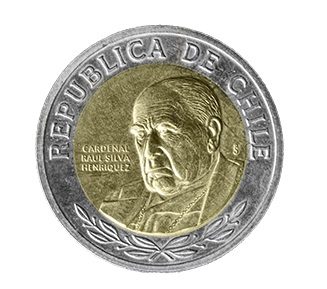
The design of the reverse of all Chilean coins shows the face value surrounded by a wreath of laurels. In the case of the $100 coin the national coat of arms also appears.
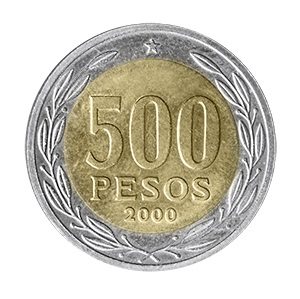
Coins of 100, 50 and 10 pesos
On the obverse of the $10, $50 and $100 coins appears the profile of Bernardo O’Higgins Riquelme (1778-1842), a Chilean military man and politician considered one of the “fathers of the Fatherland of Chile.” And two inscriptions are shown: “Republic of Chile” and “Libertador B. O’Higgins”. These coins are made with a gold-colored copper, nickel and aluminum alloy.
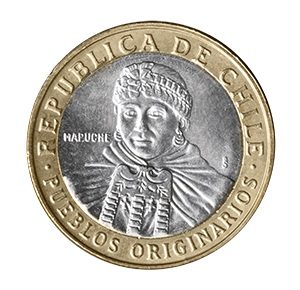
This 100 peso coin is popularly known as “gamba” in Chile. There is another more recent (bimetallic) design of the $100 coin, whose central disc is made of silver nickel silver surrounded by a golden ring of cunial alloy.
Chilean peso banknotes
Due to inflation, since its introduction in 1975 the Central Bank of Chile has been forced to issue new Chilean peso banknotes with increasingly higher values.
Until the 1990s, $5, $10, $50, $100 and $500 notes were issued that are still legal tender, but have practically disappeared from circulation.
The current series of Chilean pesos dates back to 2009 and is known as the “Bicentennial Series” (for the bicentennial of Chile’s independence from Spain in 1810).
Its values are the following:
- $1,000
- $2,000
- $5,000
- $10,000
- $20,000.
On the obverse of all these banknotes of the bicentennial series, prominent figures in the history of Chile are represented and on the reverse, natural monuments of the country.
1000 Chilean peso banknote ($1,000)
Known as “luca”, this thousand peso note is green and made of polymer. The character that appears on the obverse is Ignacio Carrera Pinto (1848-1882), captain of the Chacabuco battalion and hero in the Pacific War against the Peruvian forces in the battle of La Concepción, in Peru, between July 9 and 10. of 1882.
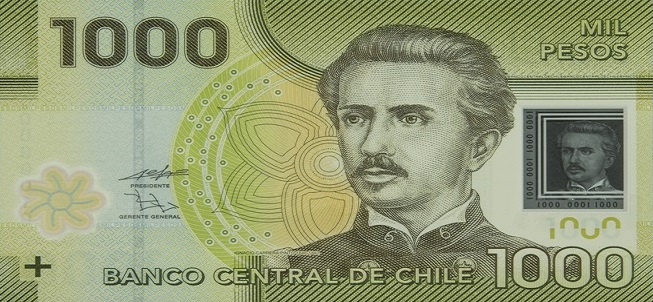
The reverse shows a famous landscape from the Torres del Paine National Park, in the extreme south of the country (Puerto Natales, in the Magallanes Region). This park was created in 1959 and stands out for its impressive landscapes. The banknote also shows two guanacos, a mammal that lives in the Andes Mountains between Peru and Tierra del Fuego.
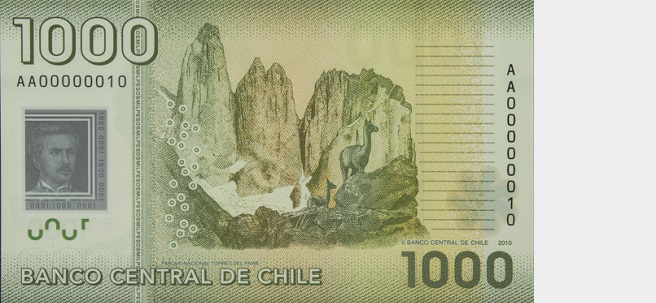
The approximate equivalent value of this euro note in France, November 2023, is about 90 euro cents.
2,000 Chilean peso banknote ($2,000)
Also made of polymer, the two thousand Chilean peso banknote is purple and its value at the current exchange rate (November 2023) is about 1.80 euros. It was put into circulation on November 17, 2010.
The figure on the obverse corresponds to Manuel Rodríguez (1785-1818), hero of Chilean independence, in command of the Hussars of Death. In the background you can see the copihue and to the left the violet Mapuche Antú symbol (the sun of the Mapuches).
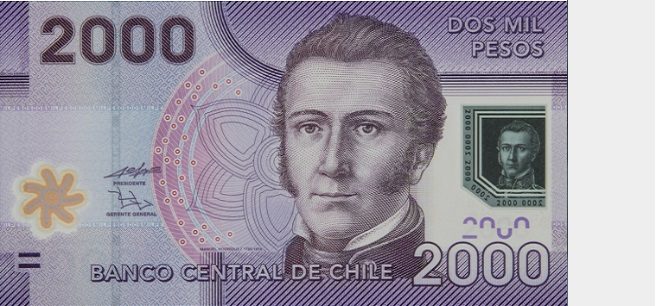
On the back appears a landscape of the Nalcas National Reserve, located in the Araucanía Region. The peregrine falcon and Darwin’s frogs live in this Reserve. Its flora is characterized by the presence of araucarias and mountain cypresses. Behind you can see the Tolhuaca volcano and the Choroy Loro, a bird that lives exclusively in the southern forests of Chile.
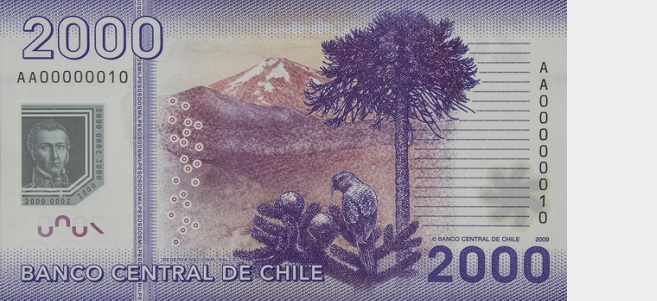
5,000 Chilean peso banknote ($5,000)
The pink banknote of five thousand Chilean pesos was the first of the bicentennial series to circulate in Chile, on September 24, 2009.
It dedicates its obverse to the Chilean poet, diplomat and pedagogue, Gabriela Mistral (1889-1957), who wrote under the pseudonym Lucila Godoy Alcayaga and won the Nobel Prize for Literature in 1945.
That is why Chileans informally call this note “gabrielita”). Behind the image of Mistral, there is the national flower of the copihue and to the left the Mapuche symbol Antú (sun).
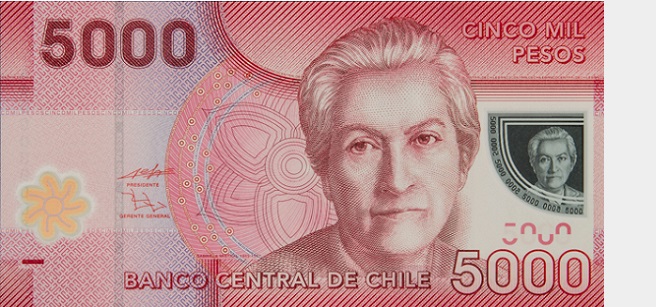
On the back of the banknote you can see the La Campana National Park, rich in Chilean palm and located in the Coastal Mountains in Valparaíso. You can see the Tucúquere bird of prey perched on a branch, a species that lives between Tarapacá and Tierra del Fuego.
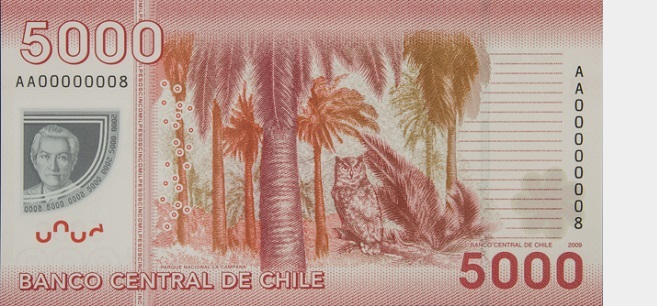
The equivalent value of this note in France, November 2023, is about 4.48 euros.
10,000 Chilean peso banknote ($10,000)
Unlike lower value banknotes, the material of the ten thousand and twenty thousand Chilean peso notes is paper. For the $10,000 note the color chosen is blue and it began to circulate in January 2010.
The obverse shows the figure of the Chilean sailor, soldier and lawyer Arturo Prat Chacón (another hero of the Pacific War) who lived between 1848 and 1879. Between 1858 and his death he participated in the wars against Spain, intervening in the naval combats of Papudo and from Abtao – and from the Pacific – where he commanded the corvette Esmeralda. The obverse is completed with an image of the Alberto de Agostini National Park, located in the Magallanes Region.
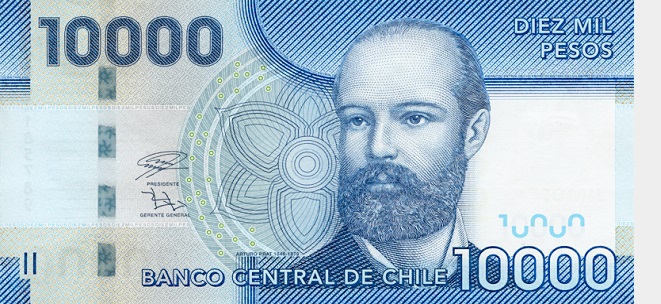
The back of this banknote is occupied by the Alberto de Agostini National Park, located in the extreme south of the Magallanes Region and Chilean Antarctica. You can also see a Condor, a national bird that lives in the Andes Mountains and Pacific coasts along with 48 other species of birds. The Coigüe de Magallanes tree predominates in the flora.
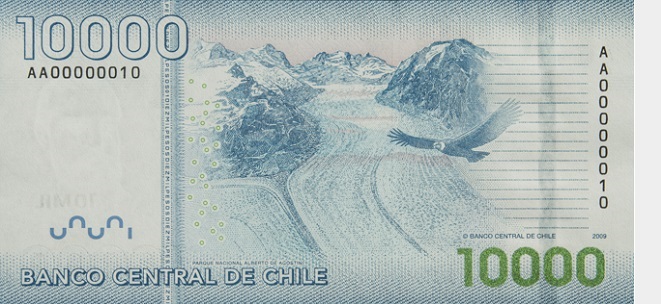
The equivalent value of this note in France, November 2023, is about 8.96 euros.
20,000 Chilean peso banknote ($20,000)
It is the highest value banknote issued by the Central Bank of Chile. It is orange in color and presents on its obverse the figure of Andrés de Jesús María y José Bello (Andrés Bello 1781-1865), first rector of the University of Chile, Senator and author of the Principles of International Law and the Chilean Civil Code. Bello is considered one of the most important humanists in America.
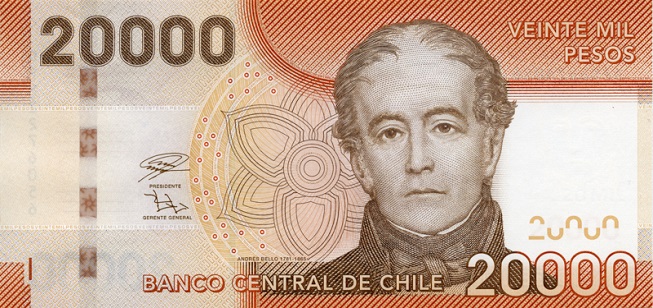
The motif on the reverse is the Salar de Surire, in the extreme north of the country in the commune of Putre, Arica and Parinacota Region. Its name comes from the Quechua word “suri” (Ñandú), “place where Rheas live.” The note’s design is completed by the flamingo, a bird that lives in areas of shallow fresh or salt water from Tarapacá to Tierra del Fuego.
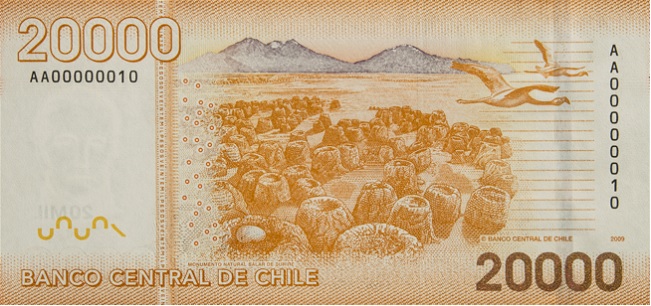
The equivalent value of this note in France, November 2023, is about 17.92 euros.
Euro to Chilean peso exchange rate
The exchange rate of the euro against the Chilean peso is subject to periodic fluctuations. If you search on Google for “Euro-Chilean peso exchange rate” you will find dozens of websites like Oanda (called “currency converters”) that offer a “rate” of the day (918 pesos per euro).
You will also see this graph with the rates of that pair of currencies from Google Finance. Something like this (November 15, 2023):
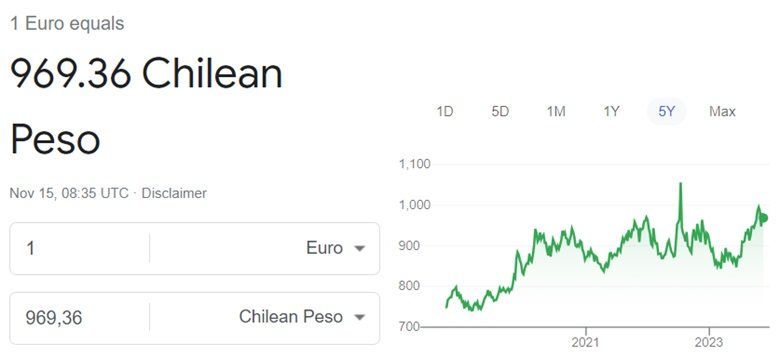
As you can see, the exchange rate in the last five years has ranged between 724 CLP and 1056 CLP per euro. But it must be taken into account that this graph represents the value of the Chilean peso “currency” against the euro, and not that of the real currency (the banknotes we use as tourists when we travel to Chile), which is lower.
In fact, in the currency suppliers in France (they are called “Bureaux de change“) you can buy Chilean pesos at an exchange rate of around 809,78 CLP for each euro that Comparer Devise gives you, or the poor 726.51 pesos that the Global exchange currency supplier gives you at the airports of Paris. Nothing to do with the euro to Chilean peso currency exchange.
Currency and banknotes of the same currency are not the same thing
So, when you see these values on Google and other currency converters with your mobile, you should keep the following in mind:
-This is an unofficial rate, and therefore not reliable. That is, if you click on the “Disclaimer” link, you get this warning from Google Finance: “Google cannot guarantee the accuracy of the exchange rates displayed. Please confirm current rates before conducting a transaction that may be affected by changes in exchange rates.”
-These rates that you see are usually wholesale prices of the Chilean peso currency against the euro currency (currency and banknotes are not the same).
-This rate can only be had between banks, that is, it is impossible to obtain it as an individual.
If you need Chilean pesos in banknotes you will have to go through the retail banknote market (bank or currency supplier). This means that the Chilean pesos have had to be “transported” by someone for you to enjoy them (or purchased from travelers from Chile passing through France previously).
Moving banknotes from one place to another has logistical costs that will make their sale price (the exchange rate that whoever sells it to you apply) increase. And maintaining a stock of Chilean pesos costs money if the currency devalues against the euro.
The Chilean peso (banknotes, not currency) is not a very abundant currency in France. As a result of its scarcity, its price is more expensive in France than in Chile.
If you decide to buy pesos in France, it is good to anticipate the purchase and order them online to get a better price. They also send them to your home or you pick them up at an exchange office near you, which are usually more interested than banks in this business.
Where to exchange Chilean pesos in France
The three most popular places to exchange Chilean pesos in France are banks, currency suppliers and the airport.
Of them, the least recommended place to buy is the airport (they give you a terrible exchange rate) and the banks, since they charge you a commission close to 3% of the amount exchanged in addition to an “exchange margin” (difference between the price per the one who paid the coin and the price for which he sells it to you).
Euro to Chilean peso exchange rate today
To know the euro tocChilean peso exchange rate, the best thing you can do is use our currency comparator.
- Change euros to Chilean pesos (EUR-CLP)
- Exchange Chilean pesos to euros (CLP-EUR)

Sin comentarios